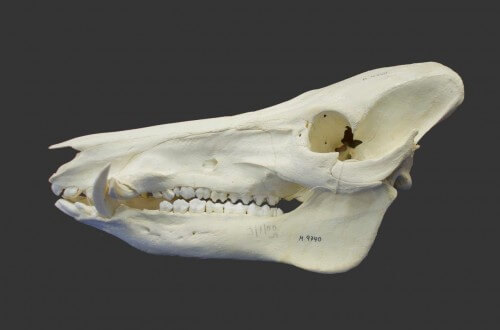A study of ancient DNA conducted at Tel Aviv University reveals that the pigs in the Land of Israel were imported from Europe 3,000 years ago

A new study shows that the wild pigs in Israel have a European genetic signature - while the pigs in Israel's neighboring countries have a Mediterranean genetic signature. According to the study, European pigs were brought to the Levant beginning in the Iron Age, most likely by the "sea peoples" - perhaps by the Philistines known from the Bible.
The results of the research were published today (November 4.11.13, XNUMX) in the journal Scientific Reports (from the Nature group) by Dr. Merav Meiri from Tel Aviv University, who conducted the actual laboratory research, - Prof. Israel Finkelstein, Dr. Dorathe Hoshon and Dr. Lider Sapir-Chen from Tel Aviv University, as well as Prof. Steve Weiner and Dr. Elizabeth Boerto from the Weizmann Institute, Prof. Guy Bar-Oz from Haifa University, Dr. Greger Larsen from Durham University, England, Prof. Aharon Meir from Bar Ilan University and Dr. Liora Kolska Horvitz from the Hebrew University of Jerusalem.
Prof. Israel Finkelstein explains that with the help of research on pigs it is possible to learn about human customs: migration patterns, dietary patterns and kitchen customs and the delineation of ethnic boundaries. Pig bones are quite common in archaeological excavations in Israel, but their concentration varies from site to site and between different periods. During the Iron Age (600-1,150 BC), for example, many bones of domesticated pigs were found in urban Philistine sites along the southern coastline of the Land of Israel compared to other sites where pig bones are rare, or do not exist at all, such as in mountain settlements attributed to the days of ancient Israel's growth in the biblical period.
The high number of pigs in the Philistine sites raises the question of their origin: did the "sea peoples" feed on local pigs or did they bring European pigs with them from the Aegean basin? Since there are no significant size and shape differences between pigs from Israel and pigs from Southern Europe, the researchers turned to genetic research that combined work on modern and ancient DNA.
The European pigs have taken over
Genetically, the domestic pig population in the world is divided into three main groups: European, Middle Eastern and the one that characterizes East Asia. To the researchers' surprise, all 25 modern wild boars from Israel tested in the study had genetic characteristics of European pigs - in contrast to wild boars from neighboring countries such as Syria, Turkey and Egypt, whose genetic characteristics are Middle Eastern. This means that at a certain time in the past, European pigs were brought to Israel, after which they took over the local pig population.
To examine this scenario and find when the population change occurred, the researchers collected pig bones from many archaeological sites throughout Israel - starting with Neolithic sites and ending with medieval sites (approximately from 9500 BC to 1200 AD). This is the most comprehensive study of ancient DNA conducted in Israel, both in terms of the number of samples and in terms of the time span.
The results show that pigs from the Bronze Age and the beginning of the Iron Age (until about 1000 BC) have a local, Middle Eastern genetic signature. A significant number of pigs with a European genetic signature appear starting in the Iron Age (around 900 BCE). It can be assumed, therefore, that the first European pigs were brought from Europe to our region by the "Sea Peoples", who migrated from the Aegean Sea region to the Levant coasts in the 12th and 11th centuries BC. In other words, it is possible that the Philistines - a group of "sea peoples" who settled in Gaza, Ashkelon and Ashdod, among others - brought with them the ancestors of the wild pigs that exist in Israel today. More European pigs were probably brought to our area in later periods, such as the Roman-Byzantine period and the Crusader period.
The researchers hypothesize that some of the "European" domestic pigs managed to escape and breed with local wild pigs, or that they were ecologically pushed out. The descendants of these ancient European pigs are the only wild pigs living in Israel today.
This discovery is one of many in a large-scale research project led by Prof. Israel Finkelstein, head of the Yaakov Alkov Department of Archeology of the Land of Israel in the Bronze and Iron Ages at Tel Aviv University, and Prof. Steve Weiner of the Kimmel Center for Archaeological Sciences at the Weizmann Institute of Science. The project harnesses the exact sciences and natural sciences to study the Iron Age (biblical days); It is conducted in 10 separate research tracks, where in each of them a question is posed from the field of archeology or history and the researchers try to answer it using methods from the exact sciences. The project was made possible thanks to a generous grant from the European Union Research Fund.

3 תגובות
Greetings
Looking for the article. Can it be attached?
Cute
Palestinian pigs? Indeed they have a long history here